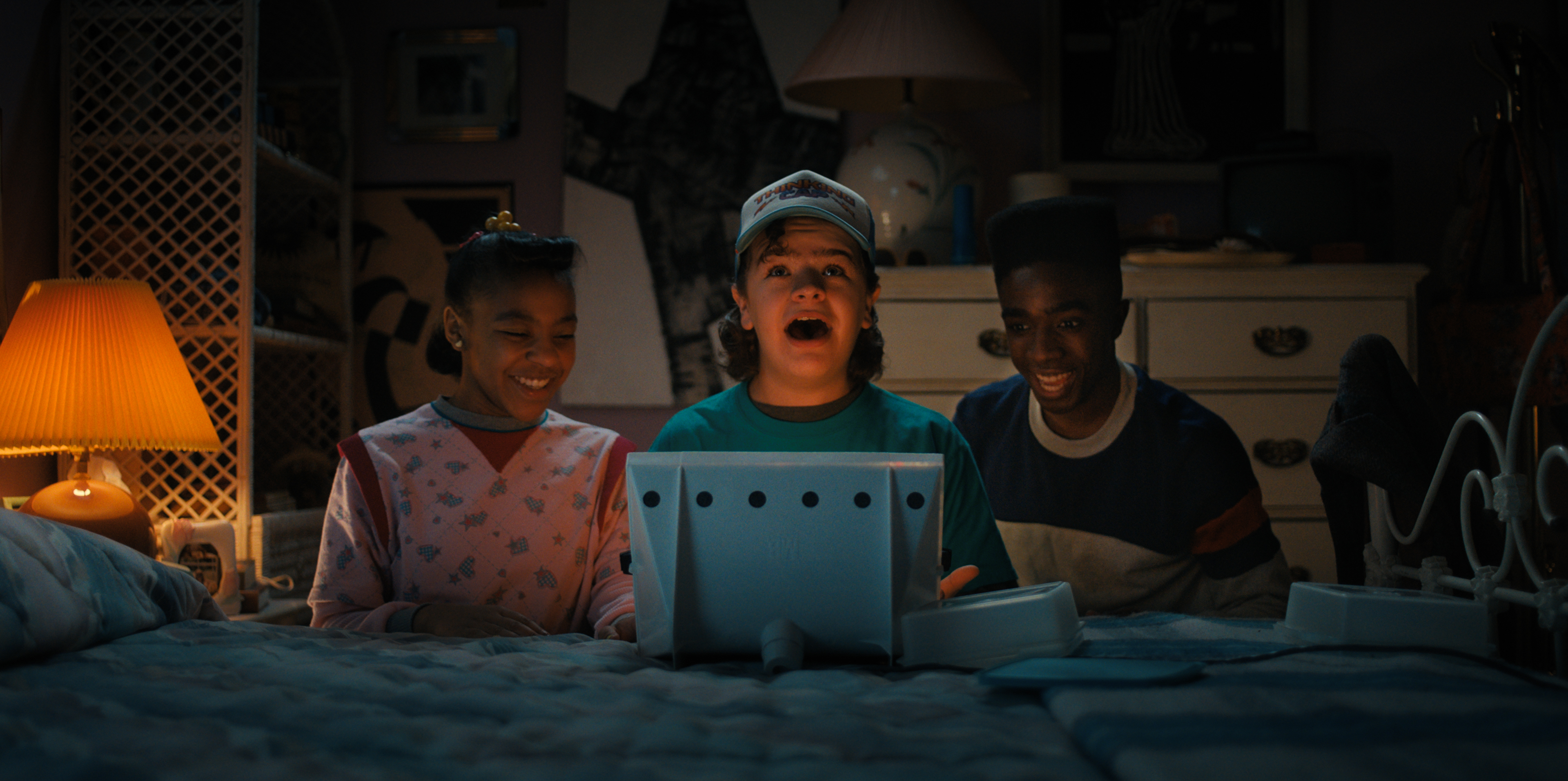Netflix is making this big mistake with Stranger Things 4
Stranger Things' release has been all Upside-Down

Netflix is, and has always been, something of an outlier. Back in the day, the established norm was to release a new TV episode each week. Then, Netflix turned that on its head by dropping new shows in one fell swoop.
As the popularity of streaming picked up, other services started following suit. Until they didn’t. These days the big streaming networks have switched back to that weekly release schedule, famously with Disney Plus' launch-day decision where we didn't get all of its highest profile show The Mandalorian at once, paving the way for a return to, dare I say it, normalcy.
Netflix has always maintained that it would not follow that charge. However, it seems as though the cracks have been forming in that stubbornness for some time. The decision to split Stranger Things season 4 into two parts is the latest, and most important example of how Netflix's release model is riddled with mistakes.
Warning: spoilers for Stranger Things season 4 follow. Read on at your own risk.
Stranger Things 4's bizarre release schedule
We all knew that Stranger Things season 4 was going to be split into two parts. Netflix told us as much in February, but we didn’t know exactly how it would be split up. Logic suggested that the season would be split in half with four or five episodes arriving on May 27, and the remainder hitting Netflix on July 1. But that’s not what happened.
Instead Netflix dropped the first seven episodes (totaling nine hours) on May 27, ending the seventh episode on an enormous cliffhanger. We left on the news that Vecna, the main villain of the season, was once One (or 001) — the very first person inducted into the experimental program where Eleven was raised.

One (real name Henry Creel) manipulated Eleven into removing an implant that impaired his powers, so he was able to go on a rampage and slaughter every other person in Hawkins National Laboratory's Rainbow Room. He was only stopped by El, who used her burgeoning powers to exile him to what appears to be a primordial version of the Upside Down.
That is a cliffhanger worthy of a season finale, or at the very least a mid-season break, to ensure people come back for the future premiere. The kind of revelation that would have you scrambling to find out what happens next.
But you can’t do that because Netflix is withholding the final two episodes to watch at a later date. I can’t help but think that this was done deliberately, and that it’s a mistake.
Why weekly releases are a good standard
If anything, the weekly release schedule is more important to networks in the streaming age. A great show spread out over six to ten weeks will let you keep hold of subscribers for a longer period of time.
A show like The Mandalorian requires someone to pay for three months of Disney Plus if they want to stay completely up to date and lessen the risk of spoilers (though it does encourage some to wait until the whole season has concluded to sign up or resubscribe). Had Disney dropped it all in one go, people could have watched the whole thing over the course of a weekend, and immediately canceled their subscription.

A weekly release also means there’s continuity, and it’s easier to drum up hype about what’s going on. The internet was abound with theories about WandaVision and what was going to happen week to week, and even Tom Holland admitted that there was an immense amount of buzz each week on the set of Spider-Man: No Way Home.
Mandalorian did it too, ending the first episode with the reveal of the then-unnamed Grogu. We called The Child by the name "baby Yoda," and people went absolutely nuts over this adorable green gremlin over the coming weeks.
Weekly releases change how a show is discussed
With both WandaVision and The Mandalorian, the wait was part of the viewing experience, and played almost as important a role as the show itself. The weekly release means there’s an even playing field for the whole audience, as not everyone watches at the same speed, and that gives them the ability to talk about it amongst themselves.
The watercooler may be more figurative in the age of social media, but principle is still there. The best thing a show can do is make people want to talk about it, especially to people who haven’t tuned in before.

While binge-watching gives you the convenience of being able to watch at your own pace, it then becomes much harder to gauge what point people are at. Talking about a show with people who aren’t at the exact same point as you runs the risk of things getting spoiled. Watching an episode one after the other also reduces the amount of time people have to discuss the show.
You have 10 seconds to come up with a theory about Vecna and what he’s about, and before you can say half a sentence the next episode has begun and you need to start paying attention to what’s on screen. In short, it becomes harder to drum up hype. Though it isn’t impossible, as shows like Stranger Things have proven.
Netflix probably knows this, but hasn’t admitted it
Stranger Things season 4 is not the first time Netflix has split up TV shows into different parts or volumes. Ozark and Lucifer are two of the best known examples, though it also happened to Chilling Adventures of Sabrina and Ashton Kutcher’s rural sitcom The Ranch.
However in other instances of this happening, the release has been staggered by a number of months. In the case of Stranger Things, the wait is just five weeks. That’s enough of a gap that it’s noticeable, but not so much that Stranger Things Season 4 volume two feels like the release of a brand new season - as was the case with the aforementioned shows.

To me it feels like Netflix is trying to have its cake and eat it too. Netflix is enduring a bit of a PR disaster right now. Subscribers are leaving en masse, shows seem to be getting canceled in greater numbers than normal and there’s the controversial decision to crack down on password sharing.
Netflix certainly does not want to turn its distribution model on its head, and potentially risk the wrath of subscribers that are still around.
Stranger Things 4 episodes should have been released differently
According to Stranger Things creators Ross and Matt Duffer, the season was split on account of its length. The two-part split idea came from Netflix CEO Ted Sarandos, and they say the decision for where to cut it came because "Episode 7 is as big as any season finale we’ve ever had." So, they said since "it is really more two seasons than one" we have to wait five weeks for Volume II.
I have my doubts about this, and not just because the first seven episodes are chock full of filler content and could easily have been slimmed down - something Tom’s Guide Streaming Editor Henry T. Casey has already spoken about at great length.

And Netflix has, repeatedly, released around 13 hours of content in one go before. The Marvel shows, House of Cards, Orange is the New Black and others all had 13-episode long seasons in Netflix's early years.
The way the season has been split is like the worst of all options. So far we’ve had just shy of nine hours of run time, and volume 2 is another four. Breaking out episodes 6 (76 minutes) and 7 (98 minutes) into the second half would have helped balance it out - and would have made more sense on paper. Six hours vs 6 hours and 45 minutes, with five episodes up first and a back-"half" of four episodes to conclude. The logical choice.
From the outside perspective it feels as though Netflix is already starting to face up to the fact that a staggered release model isn’t the worst idea in the world.
Episode 5 ended on a pretty solid cliffhanger too. Joyce and Murray crashed in Siberia, the Hawkins gang figured out a key Vecna mystery and Eleven briefly regained control of her powers - agreeing to stay with Papa to manifest them properly.
It’s not quite the same as “Vecna is One, and may have created the Upside Down as we know it”, but it would still make a pretty solid mid-season finale.
Still, someone made the decision that Stranger Things 4 would be split up, and the break wouldn’t be until the show teased us with the answer to one of its biggest mysteries and left to stew over five weeks. It feels like this moment was chosen specifically to generate some buzz, and add some further hype to the release of Volume 2. Which is also exactly how the weekly-release schedule works.
Bottom Line
It feels as though Netflix is already starting to face up to the fact that a staggered release model isn’t the worst idea in the world. The fact that it’s split up Stranger Things 4 at this shocking moment seems testament to that.
Netflix may have popularized the idea of releasing TV in binge-friendly batches, but in 2022 it feels like only it and Hulu are actually dedicated with that sort of distribution model. The rest of the streaming world seems to have moved on, and while we can’t see exactly what’s going on behind the scenes they do seem to be enjoying some success with it.

Who knows, maybe switching to a weekly release will stop Netflix from canceling so many shows — as it could have subscribers giving shows more of a chance rather than seeing them as disposable.
The question is how Netflix wants to proceed from here. There’s nothing wrong with being the outlier, and continuing to release entire seasons in one go. Likewise there’s no shame in admitting defeat, and switching back to a more traditional release method - however unpopular it may be. Amazon Prime Video has done it, and barely anyone even noticed.
Who knows, maybe switching to a weekly release will stop Netflix from canceling so many shows — as it could have subscribers giving shows more of a chance rather than seeing them as disposable.
The only thing we can say with certainty is that Netflix should not continue as it has done with the release of Stranger Things 4. Pick a lane and stay in it, rather than randomly swerving between the two.
Sign up to get the BEST of Tom's Guide direct to your inbox.
Get instant access to breaking news, the hottest reviews, great deals and helpful tips.

Tom is the Tom's Guide's UK Phones Editor, tackling the latest smartphone news and vocally expressing his opinions about upcoming features or changes. It's long way from his days as editor of Gizmodo UK, when pretty much everything was on the table. He’s usually found trying to squeeze another giant Lego set onto the shelf, draining very large cups of coffee, or complaining about how terrible his Smart TV is.
